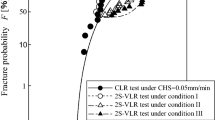Abstract
Statistical characteristics of strength distribution in ceramic components should be clarified because of large scatter in ceramics strength. Characteristics of strength distribution, however, depend on sample size, i.e., the number of tested specimens. In this study, a numerical procedure in the framework of fracture mechanics was developed to estimate strength distribution of ceramics by assuming the same statistical distribution of cracks in a material. Experimental results in four-point bending tests of alumina, which were reported in a previous work, were cited to verify the validity of the developed procedure. Smooth specimens of distinct sizes as well as notched specimens with different notch shapes were used in the experiment. Monte Carlo simulations using the developed procedure were carried out to investigate effects of the sample size on strength properties of alumina specimens with various shapes. The simulated result revealed that the experimental strength for various types of specimens was almost covered within a range of upper and lower bounds of strength simulated for the alumina. The experimental mean strength correlated with the effective volume was also included in a band range between the maximum and the minimum of mean strength obtained by the simulation.











Similar content being viewed by others
References
T. Hoshide, Strength Characteristics of Structural Ceramics, Mater. Sci. Res. Int., 1996, 2, p 220–228
T. Hoshide and J. Fujita, Simulation of Strength Distribution in Ground Ceramics by Incorporating Residual Stress Effect, J. Mater. Eng. Perform., 2008, 17, p 627–632
T. Hoshide, J. Murano, and R. Kusaba, Effect of Specimen Geometry on Strength in Engineering Ceramics, Eng. Fract. Mech., 1998, 59, p 655–665
D.G.S. Davies, The Statistical Approach to Engineering Design in Ceramics, Proc. Br. Ceram. Soc., 1973, 22, p 429–452
T. Hoshide and M. Masuda, Dependence of Strength on Size of Flaw Dominating Fracture in Ceramics, Mater. Sci. Res. Int., 1995, 1, p 108–113
T. Hoshide and T. Inoue, Simulation of Anomalous Behavior of a Small Flaw in Strength of Engineering Ceramics, Eng. Fract. Mech., 1991, 38, p 307–312
T. Hoshide, H. Furuya, Y. Nagase, and T. Yamada, Fracture Mechanics Approach to Evaluation of Strength in Sintered Silicon Nitride, Int. J. Fract., 1984, 26, p 229–239
T. Hoshide, Grain Fracture Model and Its Application to Strength Evaluation in Engineering Ceramics, Eng. Fract. Mech., 1993, 44, p 403–408
Y. Murakami, A. Aoki, N. Hasebe, Y. Itoh, H. Miyata, N. Miyazaki, H. Terada, K. Tohgo, M. Toya, and R. Yuuki, Ed., Stress Intensity Factors Handbook, Vol 1 & 2, Pergamon Press, Oxford, 1987
Y. Murakami, M.T. Hanson, N. Hasebe, Y. Itoh, K. Kishimoto, H. Miyata, N. Miyazaki, H. Terada, K. Tohgo, and R. Yuuki, Ed., Stress Intensity Factors Handbook, Vol 3, The Society of Materials Science, Japan, Pergamon Press, Oxford, 1992
Y. Murakami, N. Hasebe, Y. Itoh, K. Kishimoto, H. Miyata, N. Miyazaki, N. Noda, C. Sakae, H. Shindo, and K. Tohgo, Ed., Stress Intensity Factors Handbook, Vols. 4 & 5, Vol 4 & 5, The Society of Materials Science, Japan and Elsevier Science Ltd., 2001
Working-Group on Reference Ceramic Materials Sub-Committee on Ceramic Strength, Committee on Fatigue, Round Robin Tests on flexure Strength of Reference Ceramic Materials, J. Soc. Mater. Sci. Japan, 44, 1995, p 249–255
“Testing Method for Flexural Strength (Modulus of Rupture) of High Performance Ceramics,” JIS R 1601, Japanese Industrial Standard, Japanese Standards Association, 1995
R.W. Davidge, Mechanical Behaviour of Ceramics, Cambridge University Press, Cambridge, UK, 1979, p 138
Author information
Authors and Affiliations
Corresponding author
Rights and permissions
About this article
Cite this article
Hoshide, T., Sugiyama, H. Numerical Analysis of Sample-Size Effect on Strength of Alumina. J. of Materi Eng and Perform 22, 1–8 (2013). https://doi.org/10.1007/s11665-012-0214-3
Received:
Published:
Issue Date:
DOI: https://doi.org/10.1007/s11665-012-0214-3




